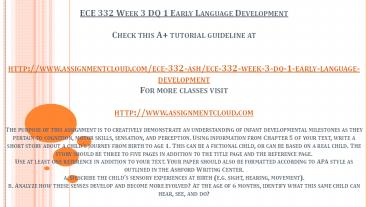ECE 332 Week 3 DQ 1 Early Language Development - PowerPoint PPT Presentation
Title:
ECE 332 Week 3 DQ 1 Early Language Development
Description:
ECE 332 Week 3 DQ 1 Early Language Development Check this A+ tutorial guideline at – PowerPoint PPT presentation
Number of Views:6
Title: ECE 332 Week 3 DQ 1 Early Language Development
1
ECE 332 Week 3 DQ 1 Early Language
Development Check this A tutorial guideline
at http//www.assignmentcloud.com/ece-332-ash/
ece-332-week-3-dq-1-early-language-developmentFor
more classes visit http//www.assignmentcloud.c
om The purpose of this assignment is to
creatively demonstrate an understanding of infant
developmental milestones as they pertain to
cognition, motor skills, sensation, and
perception. Using information from Chapter 5 of
your text, write a short story about a childs
journey from birth to age 1. This can be a
fictional child, or can be based on a real child.
The story should be three to five pages in
addition to the title page and the reference
page.Use at least one reference in addition to
your text. Your paper should also be formatted
according to APA style as outlined in the Ashford
Writing Center.a. Describe the childs sensory
experiences at birth (e.g. sight, hearing,
movement).b. Analyze how these senses develop
and become more evolved? At the age of 6 months,
identify what this same child can hear, see, and
do?
2
c. Describe what a day in this childs life might
look like by age 1. Include pictures in your Word
document or compose your story using Storybird.
Watch the video, Storybird Quick Tour, for
assistance.If you choose to create your story in
Storybird, you may collaborate with a partner in
class by using the collaboration tool. Make sure
to notify your instructor of your collaboration
and make sure both of you submit your Storybird
link in a Word document for grading. Include the
following developmental milestones in your
storya. Social and Emotional Enjoys imitating
people in his play. Shows specific preferences
for certain people and toys. Tests parental
responses to his actions during feedings. Tests
parental responses to his behavior. Prefers
mother and/or regular caregiver over all
others. Repeats sounds or gestures for
attention. Finger-feeds himself. Extends arm
or leg to help when being dressed.b. Cognitive
Explores objects in many different ways (shaking,
banging, throwing, dropping). Finds hidden
objects easily. Looks at correct picture when
the image is named. Imitates gestures. Begins
to use objects correctly (drinking from cup,
brushing hair, dialing phone, listening to
receiver).c. Language Pays increasing
attention to speech. Responds to simple verbal
requests. Responds to no. Uses simple
gestures, such as shaking head for no.
Babbles with inflection (changes in tone).
3
Says dada and mama. Uses exclamations,
such as Oh-oh! Tries to imitate words.d.
Motor Reaches sitting position without
assistance. Crawls forward on belly. Assumes
hands-and-knees position. Creeps on hands and
knees. Gets from sitting to crawling or prone
(lying on stomach) position. Pulls self up to
stand. Walks holding on to furniture. Stands
momentarily without support. May walk two or
three steps without support.e. Hand and Finger
Skills Uses pincer grasp. Bangs two objects
together. Puts objects into container. Takes
objects out of container. Lets objects go
voluntarily. Pokes with index finger. Tries
to imitate scribbling.































